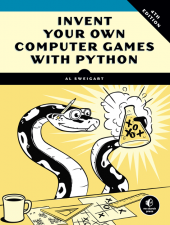Chapter 1: The Interactive Shell
Chapter 2: Writing Programs
Chapter 3: Guess the Number
Chapter 4: Jokes
Chapter 5: Dragon Realm
Chapter 6: Using the Debugger
Chapter 7: Designing Hangman with Flowcharts
Chapter 8: Writing the Hangman Code
Chapter 9: Extending Hangman
Chapter 10: Tic-Tac-Toe
Chapter 11: Bagels
Chapter 12: Cartesian Coordinates
Chapter 13: Sonar Treasure Hunt
Chapter 14: Caesar Cipher
Chapter 15: Reversi
Chapter 16: AI Simulation
Chapter 17: Using Pygame and Graphics
Chapter 18: Animating Graphics
Chapter 19: Collision Detection and Input
Chapter 20: Sounds and Images
Chapter 21: Dodger
Invent Your Own Computer Games with Python, 4th Edition
Invent Your Own Computer Games with Python was selected as one of the best books for learning Python by Real Python
“It's a great introduction to Python and a great introduction to building fairly simple but interesting games. The author's not just a talented coder, but a Python maestro. And his programming techniques provide good lessons on how to approach programming tasks.”
—Computerworld“Games are a great way to engage kids, and Python is a perfect language for them to see immediate results on the screen as they code. Invent Your Own Computer Games with Python should be a hit.”
—GeekDad
Invent Your Own Computer Games with Python will teach you how to make computer games using the popular Python programming language—even if you’ve never programmed before!
Begin by building classic games like Hangman, Guess the Number, and Tic-Tac-Toe, and then work your way up to more advanced games, like a text-based treasure hunting game and an animated collision-dodging game with sound effects. Along the way, you’ll learn key programming and math concepts that will help you take your game programming to the next level.
Learn how to:
- Combine loops, variables, and flow control statements into real working programs
- Choose the right data structures for the job, such as lists, dictionaries, and tuples
- Add graphics and animation to your games with the pygame module
- Handle keyboard and mouse input
- Program simple artificial intelligence so you can play against the computer
- Use cryptography to convert text messages into secret code
- Debug your programs and find common errors
As you work through each game, you’ll build a solid foundation in Python and an understanding of computer science fundamentals.
What new game will you create with the power of Python?
The projects in this book are compatible with Python 3.
Check out an interview with Al Sweigart on the Talk Python to Me podcast!
Recommended by Geekdad in their “Ultimate-est List of Toys, Kits, and Books to Teach Kids Coding”
“...Pretty close to the ultimate how-to-learn python book. First, it combines an easy ramp up from expecting you to know virtually nothing to having you try out – and understand – Python. Second, it provides the code, the tools, and the explanations required for you build a number of increasingly sophisticated games and the know-how to branch out to creating games completely on your own.”
—Computerworld
“Many of the games include flowcharts so the reader will better understand the logic needed to complete the game, and I was especially happy to see a few chapters focus on topics not necessary limited to games such as Cartesian coordinates and using the built-in Debugger.”
—GeekDad
“This is an excellent way to learn Python, if you are a kid or not. Little kids can learn with their adult guide, and older kids will eat this book up in an afternoon or two.”
—Greg Laden, National Geographic's ScienceBlogs
“This book is a great entry point for beginning programmers that 'gamifies' coding, allowing readers to immediately apply the concepts covered, rather than teaching basics with little application.”
—School Library Connection
"If games are your thing, this would be the perfect book to learn Python."
—Rajat, @argent_codes
Featured on STEM Friday
View the latest errata.

